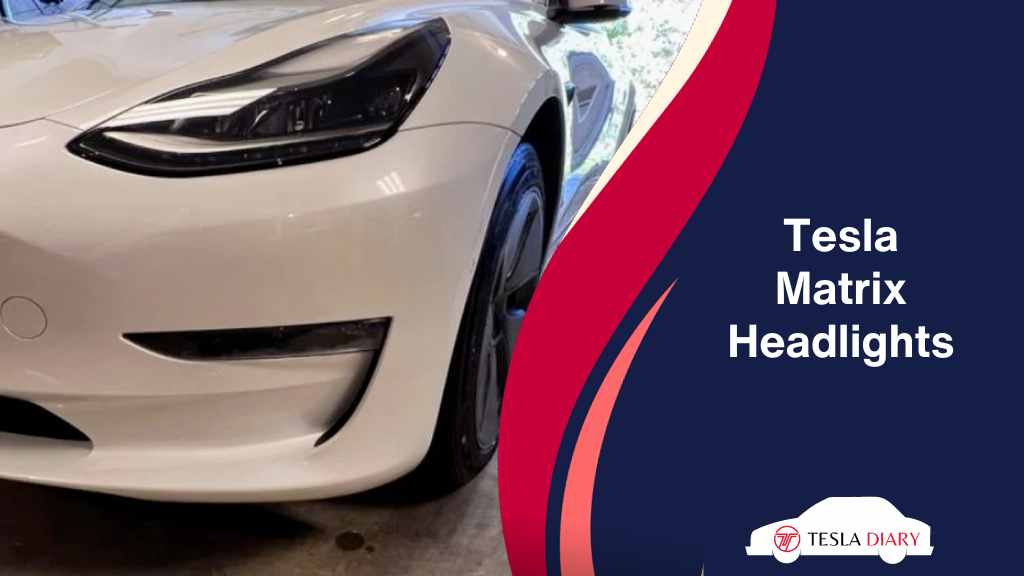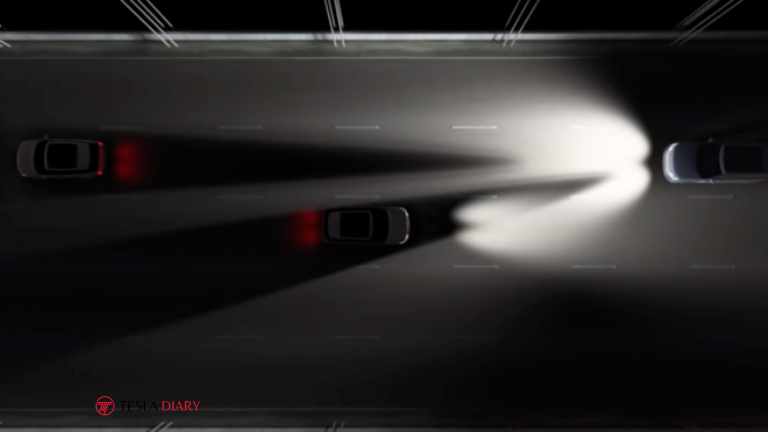Tesla Matrix Headlights are a testament to the company’s commitment to innovation and safety on the road.
In this comprehensive guide, we will delve deep into what Tesla Matrix Headlights are, how they function, whether Tesla incorporates them into their vehicles, how to properly adjust them, the possibility of retrofitting them to older models like the Model 3, and how they stack up against traditional LED headlights.
By the end of this exhaustive article, you will have all the information you need to make an informed decision about the worthiness of Tesla Matrix Headlights.

What are the Tesla Matrix Headlights?
Let’s begin by understanding what exactly Tesla Matrix Headlights are. These are advanced adaptive headlight systems that employ a matrix of individually controllable LEDs to provide optimal illumination while driving.
Unlike traditional headlights that have fixed beams, Matrix Headlights can adapt to changing driving conditions in real time. They rely on sensors and cameras to detect oncoming traffic, pedestrians, and other vehicles, adjusting the intensity and direction of the light beams accordingly.
One key feature of Tesla Matrix Headlights is their ability to create “light zones.” These are specific areas of illumination that can be controlled independently.
By dimming or intensifying particular zones, Matrix Headlights can effectively shade out oncoming vehicles to prevent glare while keeping the rest of the road well-lit.
This technology allows for improved visibility without compromising the comfort and safety of other drivers.

Does Tesla Use Matrix Headlight?
Yes, Tesla has integrated Matrix headlights into models such as the Model S Plaid, Model 3, and Model Y, offering their benefits to a broader range of drivers.
Tesla’s commitment to innovation extends to all its models, and the Model X is no exception. While Matrix headlights may not have been available on the Model X initially, reports indicate that Tesla is actively working to bring this technology to the Model X as well.
Despite the incorporation of Matrix headlights into its vehicles, Tesla’s implementation may still have some limitations. One potential area of concern is the range of flexibility provided to users.
In some cases, Tesla owners might find that they are limited in their ability to customize or fine-tune the Matrix headlights to suit their specific preferences. This limitation could be viewed as a potential drawback for those who seek more granular control over their vehicle’s lighting system.
How To Adjust The Tesla Matrix Headlight?
Properly adjusting your Tesla Matrix Headlights is essential not only for your own safety but also for the safety of other road users. These advanced headlights are designed to provide optimal illumination while minimizing glare for oncoming traffic. Here’s a comprehensive and informative guide on how to adjust the Tesla Matrix Headlights:
1. Park the Car Facing a Wall
Begin by parking your Tesla in an area that is level and free from obstructions. This will provide you with a stable and clear working environment for adjusting the headlights.
- The parking space needs to be flat and your tires must be properly inflated.
- This should be done at night for ease of work.
- Make sure the wall is at least 2 meters high and 4 meters wide.
2. Mark the Wall
To create reference points, place horizontal strips of masking tape or painter’s tape on the wall in front of your Tesla.
These strips should be at the same level as your headlights and act as a visual guide during the adjustment process. The tape should be around 28-30″ from the ground.
3. Position the Car for Adjustment
Position your Tesla about 25 feet (approximately 7.6 meters) away from the wall. This distance allows for proper headlight adjustment and alignment without being too close or too far.
Make sure the whole place is flat.
Also, if you don’t have enough space for this to work. You can do the same from 10 feet distance. In that case, you will need to increase the reference point height to 36 inches.
4. Start Adjusting Headlights
Access your Tesla’s touchscreen interface and navigate to the ‘Service’ section in the Controls menu. Look for the option to enable the headlight adjustment mode.
This mode allows you to adjust the headlights while keeping them on, making it easier to see the changes in real time.
5. Adjust the Left Headlight First
Before adjusting the left headlight, cover the right headlight with a towel or something so that you can only see the light coming out of the left one.
Use the steering wheel button as instructed in the touchscreen to adjust the left headlight beam of your Tesla. This is called vertical alignment.
The beam should not go above the reference point you have marked on the wall.
6. Adjust the Right Headlight Beam Level
Now, turn your attention to the right headlight. Similarly, cover the left headlight and use the same settings and buttons to adjust the right headlight beam level.
Throughout the adjustment process, keep a close eye on the horizontal strip of tape on the wall, which represents the reference point for the headlights’ level. Ensure that both headlights are adjusted to align with this reference, making them level and symmetrical.
Once you are satisfied with the alignment of both headlights, exit the headlight adjustment mode on your Tesla’s touchscreen interface.
7. Take the Car to a Test Drive
Once you are done with the adjustment process, it is imperative that you check the headlights in a real traffic environment. Drive slow and observe whether the adjustment is perfect for you and the oncoming drivers.
There may be instances when you might want to readjust the headlights due to the road conditions, uneven terrain, sharp turns, etc. The test drive will give you an idea of whether you need further adjustment or not. If it is needed, adjust the headlight slightly according to your preference.
Please consider the comfort of the oncoming drivers when adjusting. It is advised that you do not move the focal point of the headlight beams higher than the recommended level of 30″ from 25 25-foot distance. By minimizing glare for oncoming drivers, you contribute to overall road safety.
Tesla Matrix Headlights vs Old LEDs
Now that we’ve covered how to adjust Matrix Headlights and their retrofit possibilities, let’s delve into how they compare to traditional LED headlights. Here’s a detailed comparison:
| Feature | Tesla Matrix Headlights | Traditional LED Headlights |
|---|---|---|
| Adaptive Lighting | Yes (Real-time adjustments) | No (Static lighting) |
| Light Zoning | Yes (Precise control) | No (Uniform lighting) |
| Energy Efficiency | High (Selective illumination) | Moderate (Uniform lighting) |
| Safety Enhancement | Yes (Minimizes glare) | Limited (Static beams) |
| Customization Options | Extensive (Dynamic signals, etc.) | Limited (Basic functionality) |
1. Adaptive Lighting:
Matrix headlights offer dynamic adaptive lighting. They adjust their beams in real time, providing better visibility without blinding other road users. They can create light zones to selectively illuminate areas of the road while avoiding glare for oncoming vehicles.
Traditional LED headlights are static and do not adapt to changing road conditions. They provide a constant light pattern without the ability to adjust to different driving situations.
2. Efficiency:
Matrix Headlights use individual LEDs that can be controlled with precision. This not only allows for adaptive lighting but also enhances energy efficiency. They consume only the necessary power for the current driving situation, maximizing efficiency.
While traditional LED headlights are energy-efficient compared to halogen lights, they do not offer the same level of control and efficiency as Matrix Headlights.
3. Safety:
The adaptive nature of Matrix Headlights improves safety by illuminating the road ahead more effectively and reducing glare for other drivers. They enhance your visibility, especially in challenging conditions like heavy rain or fog.
Traditional LED headlights provide good visibility but lack the adaptive features that can further enhance safety.
4. Customization:
Tesla Matrix Headlights often come with customizable features such as dynamic turn signals and automatic high-beam control. These features add to the overall driving experience.
Traditional LED headlights may offer limited customization options, mainly related to brightness adjustment.
Are Tesla Matrix Headlights Worth it?
The million-dollar question for potential Tesla buyers and enthusiasts: Are Tesla Matrix Headlights worth the investment? The answer to this question depends on your preferences and priorities as a driver. Let’s break it down:
1. Enhanced Safety:
If safety is a top priority for you, Matrix Headlights are a valuable addition to your vehicle. Their adaptive nature and the ability to create light zones contribute significantly to safer nighttime driving.
2. Technological Innovation:
Tesla Matrix Headlights are a testament to Tesla’s commitment to cutting-edge technology. If you’re an early adopter and appreciate the latest advancements in automotive tech, these headlights will likely be appealing.
3. Improved Visibility:
Better visibility on the road is a primary benefit of Matrix Headlights. If you frequently drive in low-light conditions or on poorly lit roads, the improved illumination can be a game-changer.
4. Customization:
The customizable features that often come with Matrix Headlights can enhance your overall driving experience. Features like dynamic turn signals add a touch of luxury and sophistication to your Tesla.
However, it’s crucial to consider the cost factor. Tesla Matrix Headlights, being a premium feature, can significantly add to the price of your vehicle. Before making a decision, evaluate your budget and determine whether the features offered by Matrix Headlights align with your driving needs.
Also, the Matrix headlights do not offer their full potential yet and it is unclear whether Tesla owners will be able to utilize the full potential of the Matrix headlights in the future as well.
Can Model 3 Matrix Headlights Retrofit?
Retrofitting Tesla Matrix Headlights is not a readily available option for the Model 3. Retrofitting advanced headlight systems like Matrix Headlights can be complex and is not officially supported by Tesla.
However, you can retrofit Matrix headlights in your old Tesla Model 3 by third-party services which I do not recommend. You won’t gain anything special by spending the money on replacing the Tesla headlights while the car might start having errors because of unsupported accessories.
Final Verdict
Tesla Matrix Headlights represent a significant advancement in automotive lighting technology, providing enhanced safety, adaptive lighting, and customization options.
While traditional LED headlights are an improvement over halogen lights, they may not offer the same level of control, efficiency, and safety as Matrix Headlights.
The choice between the two ultimately depends on your priorities as a driver and your preference for advanced features and customization.

